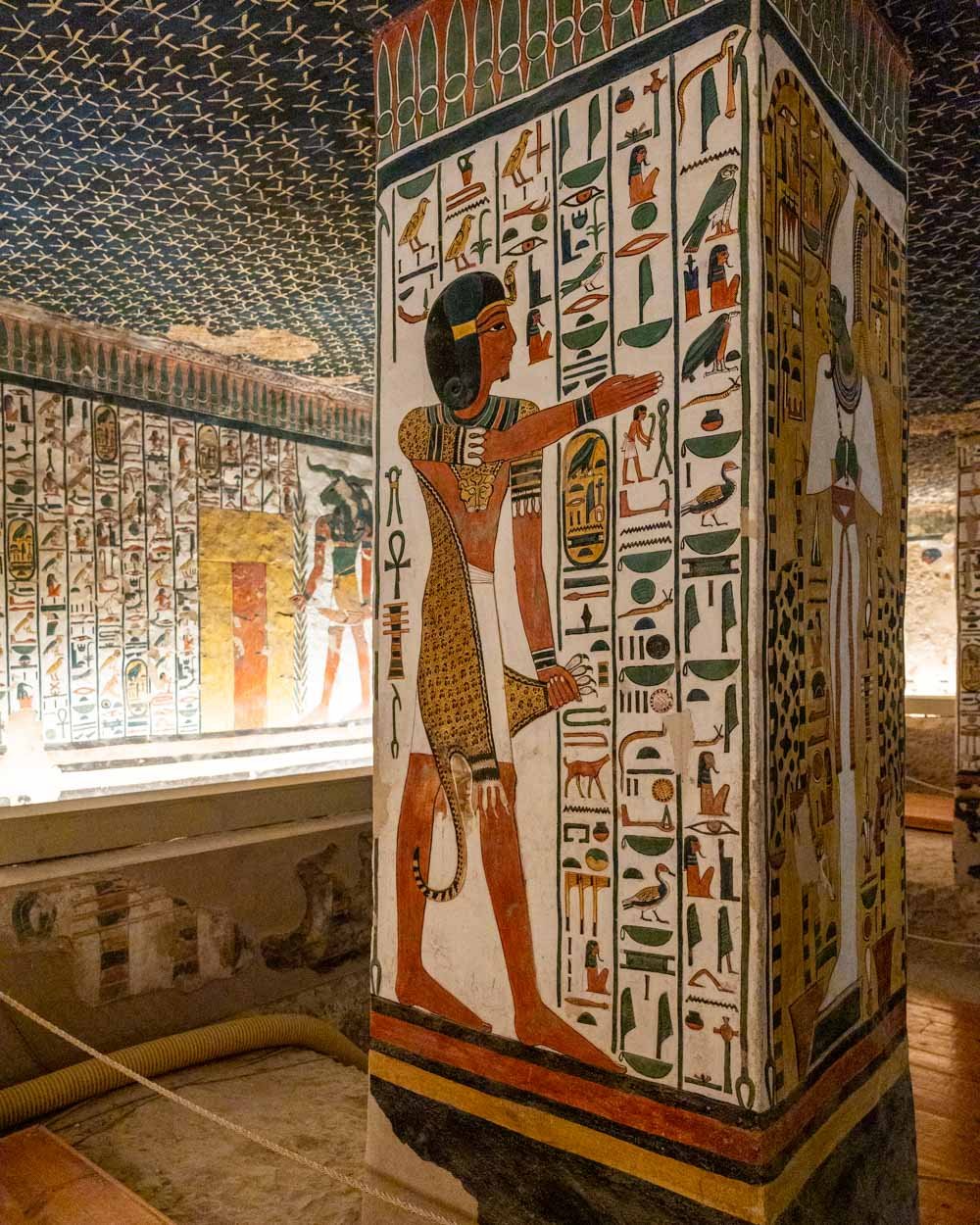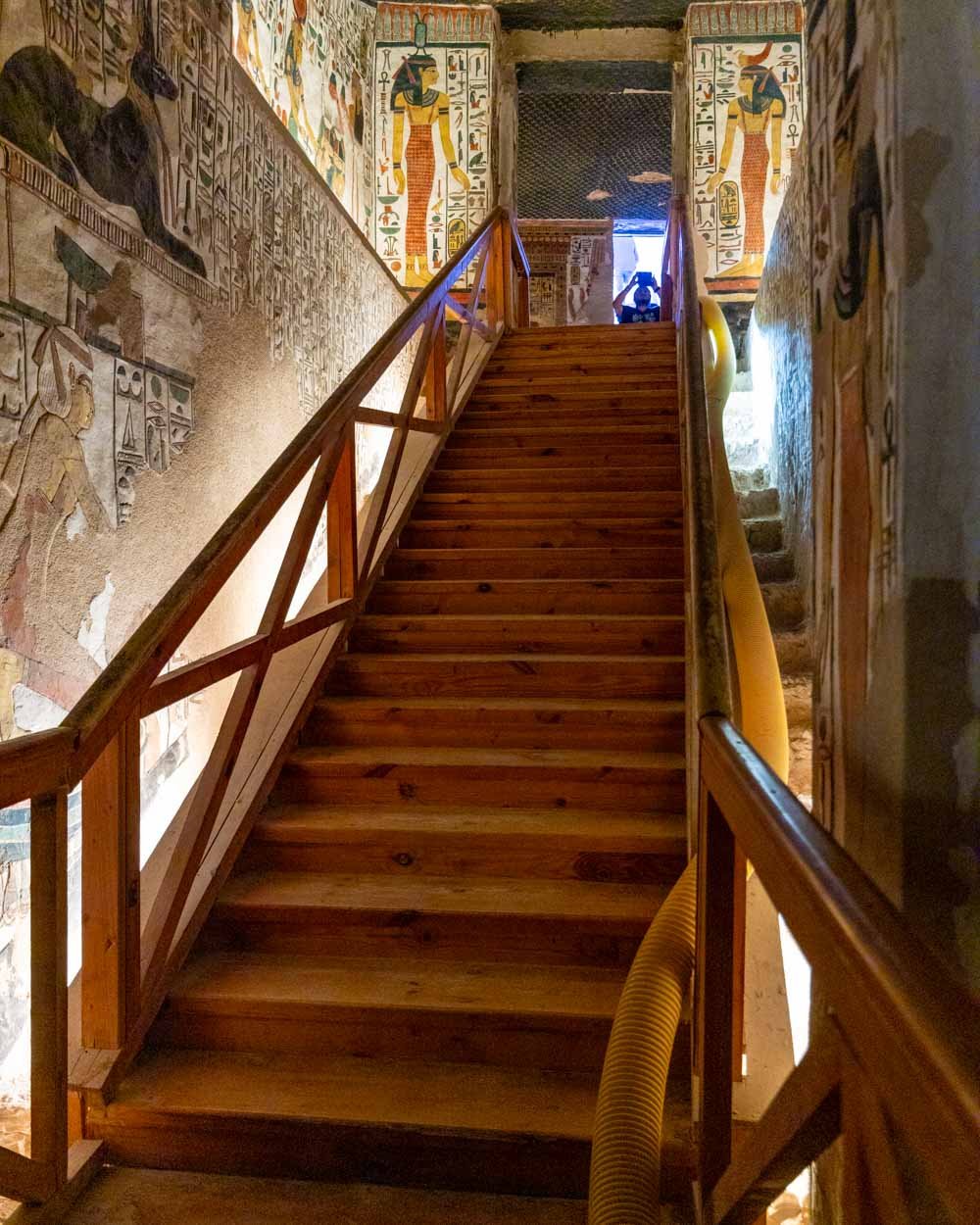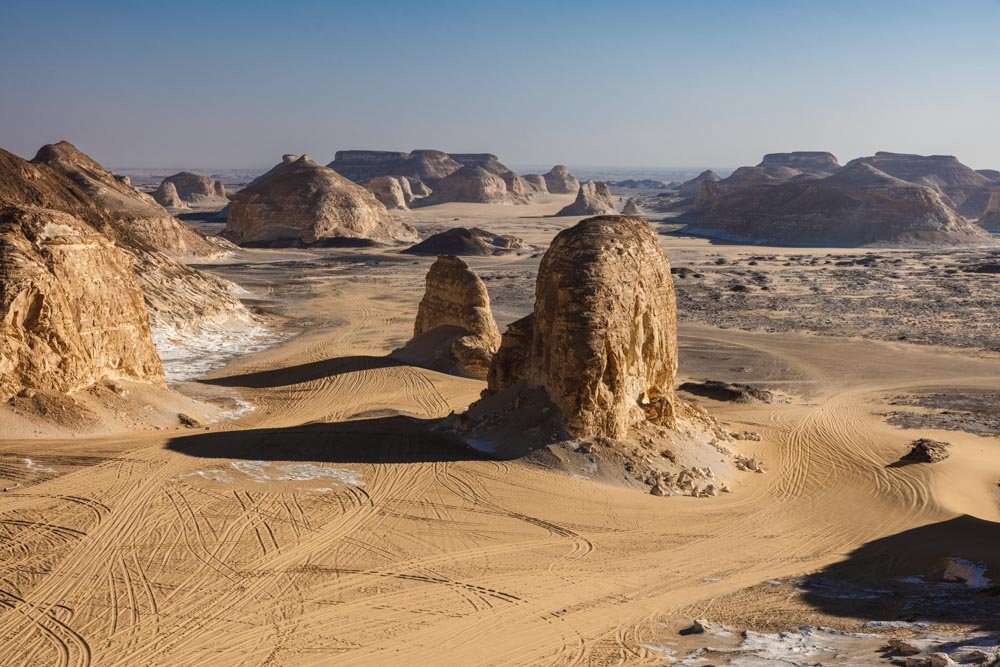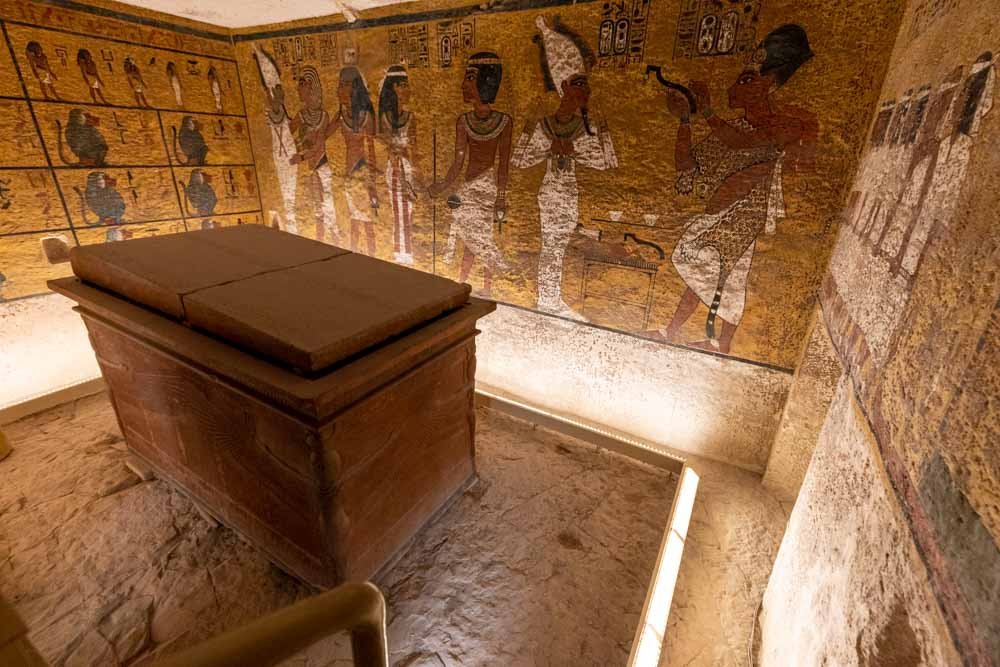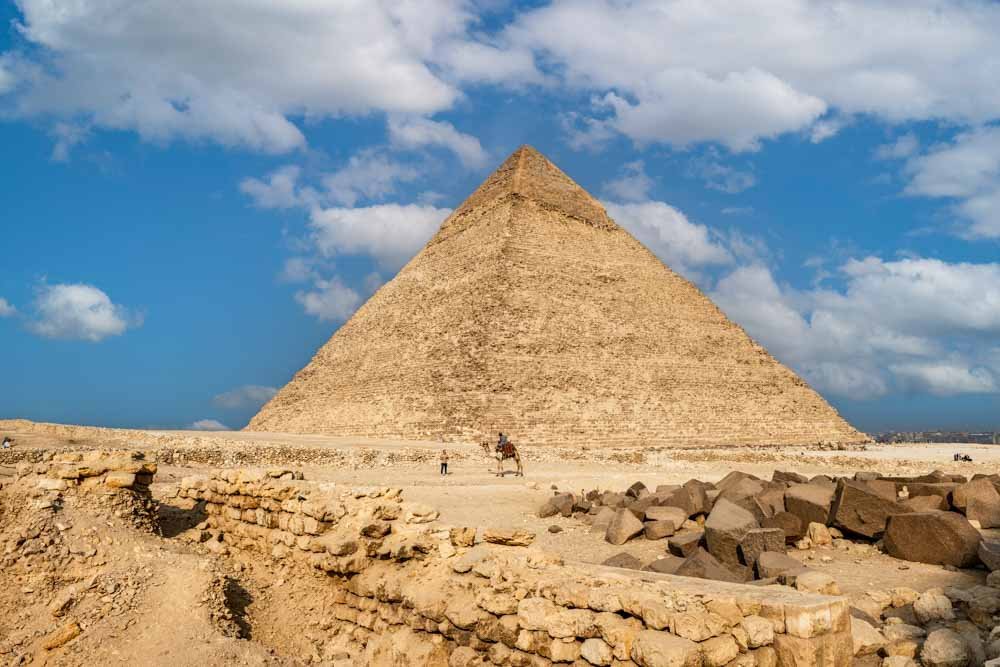Queen Nefertari's tomb: a tomb you can visit for a mere 10 minutes, that at the current exchange rate costs you USD $45, but was a staggering USD $87 a few months earlier when I started researching our trip (the ticket has remained 1400 EGP throughout). The first time I saw the price it was written in the Egyptian currency and I thought it was a typo. Could it possibly be 14 times the cost of all of the rest of the tombs in the Valley of the Queens combined? It turns out that it can.
We knew we had to visit. The allure of a tomb so exquisite that these prices could be charged was just too much.
In this guide we’re sharing exactly what it’s like to visit Nefertari’s tomb and whether we thought it was worth it.
The tomb of Queen Nefertari
The paintings
Having visited every tomb in the Valley of the Queens (and Kings), you can trust us on how the experience in Nefertari’s tomb compares to others.
When it comes to the three other tombs open in the Valley of the Queens, Nefertari’s tomb stands head and shoulders above the rest in every way. For starters, it’s the only tomb in the Valley of the Queens (open to the public) which is not shrouded in glass.
Although we understand the glass needs to be there for preservation, when it comes to the experience of trying to immerse yourselves in the artwork, it does detract. It’s also hard to get glareless photographs.
But to be honest this is a small factor compared to the quality of the artwork itself. Nefertari’s tomb is simply magnificent. Having not long been open to the public, the majority of paintings are almost pristine. In fact they are so vivid it’s honestly hard to believe they could be 3200 years old.
Every minute you spend wandering the chambers you’ll see more awe inspiring detail.
Queen Nefertari was the favourite wife of Rameses II and it shows, her tomb is a shrine to, and celebration of her beauty from youth all the way through to older age (although the last picture depicts her as quite old, she was actually only 44 when she died, so young by today’s standards).
A young Nefertari with tattoos
The “older” Nefertari
There are no paintings in the Valley of the Queens (or Kings) which compare to Nefertari’s tomb, they are just so vivid and pristine and adorn almost every inch of the walls.
The experience in the tomb
As with all the tombs in the Valley of the Queens, the entrance is easy to get to. In fact Nefertari’s tomb is the first you’ll come to and just a 250m flat walk from the ticket office.
To enter the tomb requires walking down several staircases, but they are not as long or steep as many in the Valley of the Kings, so it’s suitable for anyone who can manage a few staircases (which are equipped with handrails for the most part).
Once inside there are two levels to explore. The tomb is not that big, but there’s a lot to see. It gets incredibly hot down there though and the fans do little to combat the stifling heat. Luckily the number of people who can enter the tomb at any one time is limited, so it can’t get too crowded (although at times it still felt busy).
There are a couple of tomb guardians (as with every tomb in the area) who will come and see you at some point. They will point out a few special paintings (such as one showing Nefertari’s tattoos and one showing her at an older age), they will expect a small tip if you engage/allow them to take your photo.
The tomb is well lit, but not so bright as to detract from the experience.
If you want to see the tomb with as few crowds as possible it’s best to visit when it first opens (6am) or near to closing time (5pm).
But do check the opening times are the same during your visit as things seem to change often in Egypt.
The 10 minute rule
Nefertari’s is the only tomb in either valley that has a time limit on it, and this is written on a sign outside the tomb. Ten minutes is not nearly enough to really take in the incredible paintings and you will not be allowed a second visit (even if you have the premium Luxor Pass you can only visit on another day, not twice on the same day).
Your only way around this is to pay a little baksheesh and this option will almost certainly be offered to you. You won’t be asked for money, but you will be told something like ‘stay a little longer, or you can have 15 minutes’ etc etc.
You will be expected to tip for this. I actually ended up being given 45 minutes. It was a bit like 45 minutes in an inferno, but it was oh so worth it. Although it would take far longer to take in all the paintings, I felt like I got to see much more detail than I would rushing through in ten minutes.
In terms of how much to tip, it really depends on you. For five extra minutes you wouldn’t need to pay much at all. Maybe 10 - 20 Egyptian pounds (USD $0.30-0.60 at today’s exchange rate), but for much longer you would be looking at more.
Our understanding is that the tomb guardians are paid very poorly, so I gave USD $5 for my 45 minute stay - a lot by Egyptian standards, but I was chuffed to bits with my extra time.
Photography inside the tomb
Rules regarding photography change constantly in Egypt. We got very lucky, and photography with any type of camera was allowed in every tomb for free. This was my third visit to Egypt and sometimes all photography is allowed, sometimes only cellphone photography and sometimes non whatsoever.
Don’t make the mistake we did at the Great Pyramid and leave your camera behind trusting what’s written on the internet - things change too often for that. Bring your camera and if the rules have changed you can just put it away, or maybe pay a little baksheesh….
The history of Queen Nefertari
Nefertari was the much beloved wife of one of the greatest pharaohs and most prolific builders of Ancient Egypt, Rameses II. Despite having several wives, Nefertari was clearly his favourite as she appears regularly at temples and many of Rameses II constructions.
This is most obvious at Abu Simbel where, not only does it have a temple dedicated to her (and the Goddess Hathor), she also has her own colossi, which is the same height as Rameses himself (usually wives are much smaller).
Next to these colossi is the text “A temple of great and mighty monuments, for the Great Royal Wife Nefertari Meryetmut, for whose sake the (very) sun does shine, given life and beloved".
Nefertari was also an accomplished diplomat and it was believed that her relationship with the Hittite King Hattusili III and his wife Queen Puduhepa helped to bring peace between Egypt and the Hittites.
So is Nefertari’s tomb worth it?
For me the answer to this question is definitely yes, even though I did, and still do wince at the price. Its beauty is unrivalled in the Valley of the Queen’s. It also has more pristine paintings than any tomb in the Valley of the Kings. However, the paintings in the tombs in the Valley of the Kings are also incredible, so you won’t miss out on seeing wonderful artwork if you don’t visit Nefertari’s tomb.
The premium tombs in the Valley of the Kings are cheaper than Nefertari’s tomb, so if you simply want to see one of the most special tombs in the area you could pick Seti I or Rameses V&VI (don’t pick Tutankhamun’s if you want to see the best art).
However, having said all that there is something very special about Nefertari’s tomb, and it is unlike any other, so perhaps it’s one of those things you think you’ll only do once and just go for it!
Depending on the exchange rate you may be better off buying the premium Luxor Pass if you do choose to visit. When I first looked into the pass Nefertari’s tomb’s equated to USD $87. Seti I tomb in the Valley of the Kings was USD $60.
The two combined almost covered 3/4 of the cost of the premium Luxor Pass alone. This makes the tomb feel less expensive. However when we actually got to Egypt, the Egyptian pound had fallen hard against the dollar.
Nefertari's tomb became USD $45, which is better value if you’re buying it alone, but made the pass poorer value. So do watch for the exchange rate as it can make a huge difference.
Getting to the Valley of the Queens
Assuming you don’t want to visit on a tour you can easily hire a taxi in Luxor, or at the ferry terminal on the West Bank. You’ll need to haggle, and make sure you state the wait time you want included. Visits to the Valley of the Queens are usually made in conjunction with the Valley of the Kings and other sites on the West Bank.
How much you pay will depend on how much you want to haggle and how far away you can negotiate from a big hotel. If you’re hanging around places like the Hilton, it’s hard because the drivers all have the rates the hotel charges (600 EGP for 5 hours at time of writing). This is much more than you can pay by negotiating with a driver directly, and as I say preferably not near an expensive hotel! The cheapest price we were offered for a full day on the West Bank pre haggle was 400 EGP.
The journey between Luxor and the Valley of the Queens takes around 50 minutes. It’s much quicker if you take the ferry. You should technically get a cheaper taxi price from the West Bank, but we always went from Luxor city.
This post may contain affiliate links, meaning at no additional cost to you, that we will earn a small commission if you click through and decide to make a purchase. This helps towards the costs of running our website. Thanks for your support!


